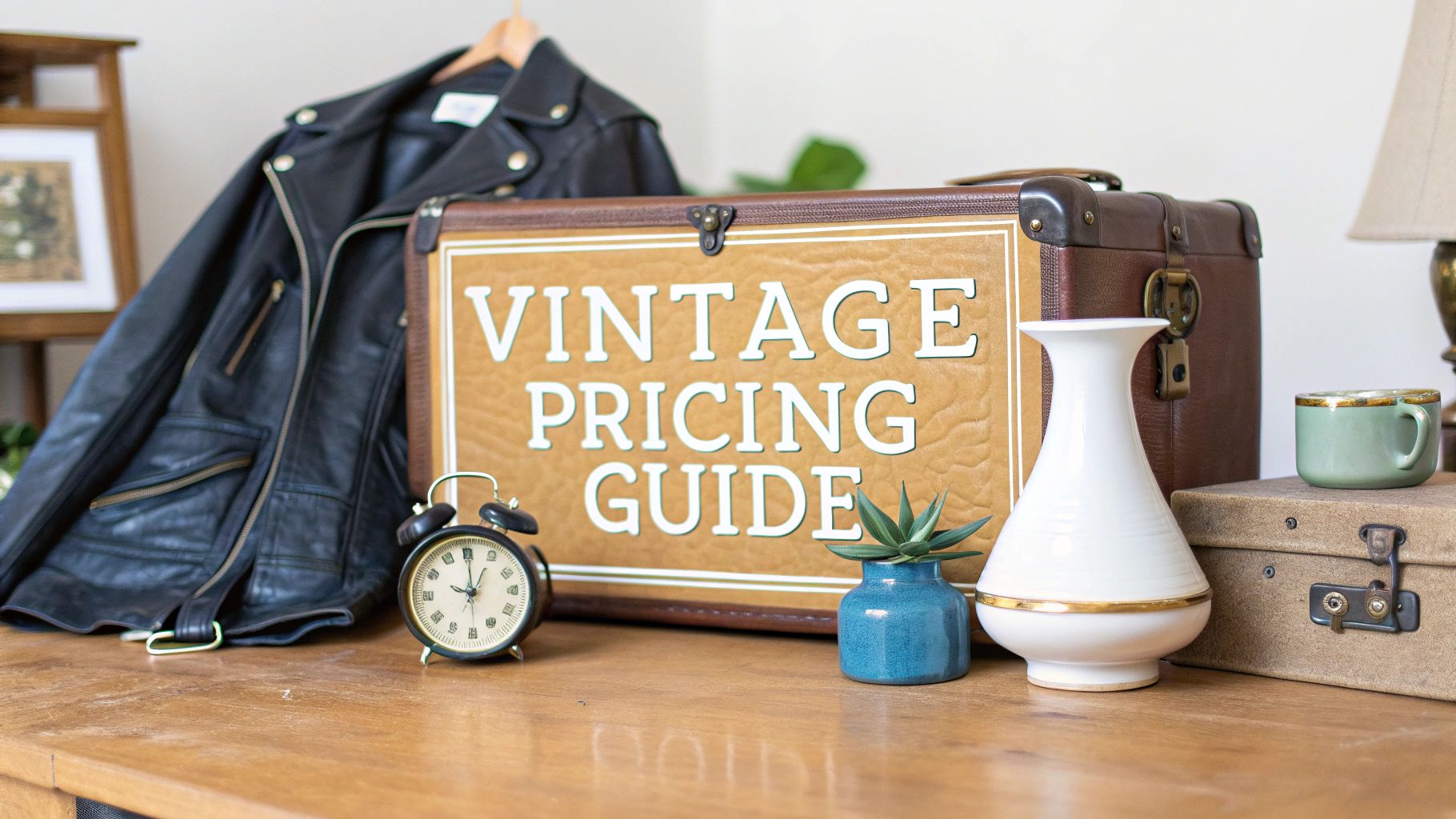A solid vintage pricing strategy stands on four pillars: Condition, Rarity, Provenance, and Demand. Think of them as the legs of a table—if one is shaky, the whole thing becomes unstable. Getting a feel for these four elements is the first step to pricing your vintage finds with confidence.
Understanding What Drives Vintage Value
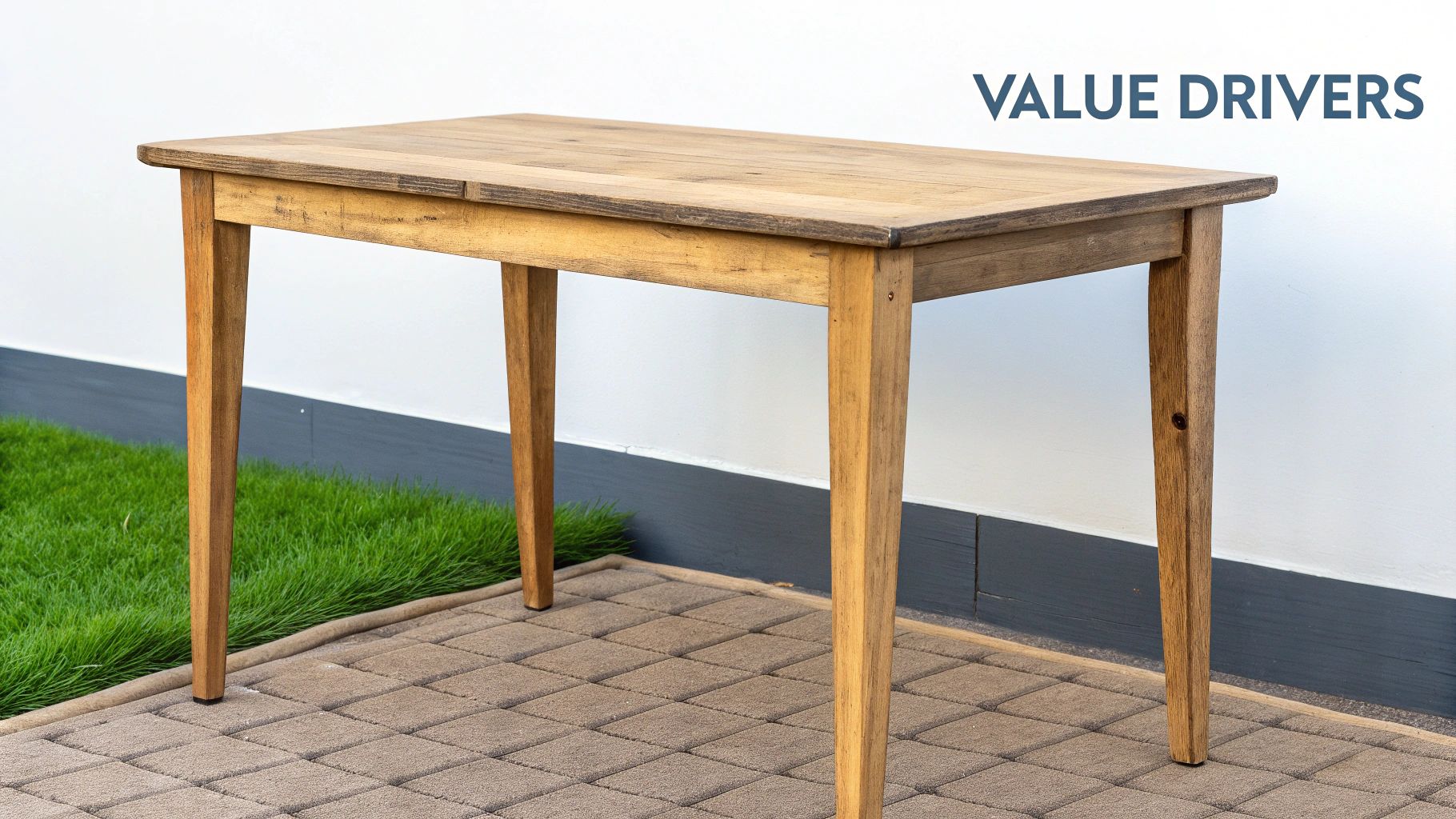
Before you can put a price tag on anything, you need to understand what actually gives it value in the first place. It’s a common mistake to think that old automatically means valuable. While age is part of the equation, it’s just one piece of a much bigger puzzle.
An item's true worth is a story told by its physical shape, how many are left in the world, its history, and how much people want it right now. Pricing isn't just guesswork. It's about looking at all the clues and putting them together. Skip one of these steps, and you risk either leaving money on the table or having an item sit on your shelf forever.
The Four Pillars of Vintage Valuation
I like to think of these four factors as a mental checklist for every single piece I consider. An item might be a ten-out-of-ten in one category but a two in another, and the final price has to reflect that reality. Let's break them down.
Here’s a quick overview of what to look for.
| Core Factors Influencing Vintage Value | | :--- | :--- | :--- | | Valuation Factor | Description | Impact on Price | | Condition | The physical state of the item. Is it pristine, or does it show its age with scratches, chips, or fading? | High. An item in mint condition can be worth double or triple one in just "fair" condition. | | Rarity | How hard is it to find? Was it a limited run, or were millions made? | High. The fewer there are, the more a collector is generally willing to pay. | | Provenance | The item's backstory. Who owned it? Does it have original packaging or receipts? | Varies. A compelling history can significantly boost value, especially with a famous previous owner. | | Demand | Are people actively searching for this right now? Is it trending or part of a niche collector's market? | High. An item is only worth what someone is willing to pay today. Hot trends can create huge price spikes. |
Each of these elements plays a critical role in painting the full picture of an item's market value.
Let's take Condition as an example. This is probably the most obvious factor, but its impact is huge. A piece in mint or near-mint condition might fetch 100% of its top market value. But the exact same item in fair condition, with visible wear and tear, could struggle to get even 30-50% of that price.
This is especially true for items from brands that no longer exist, where finding a replacement part is impossible. Every little flaw matters.
For instance, a classic watch isn’t just a timepiece; it's a collection of value-based attributes. You can find expert guidance on valuing luxury timepieces that shows how model, condition, originality, and market demand all work together to determine a final price. This same logic applies to furniture, ceramics, and clothing. Each element tells a piece of the value story.
How to Assess an Item's Condition Like a Pro
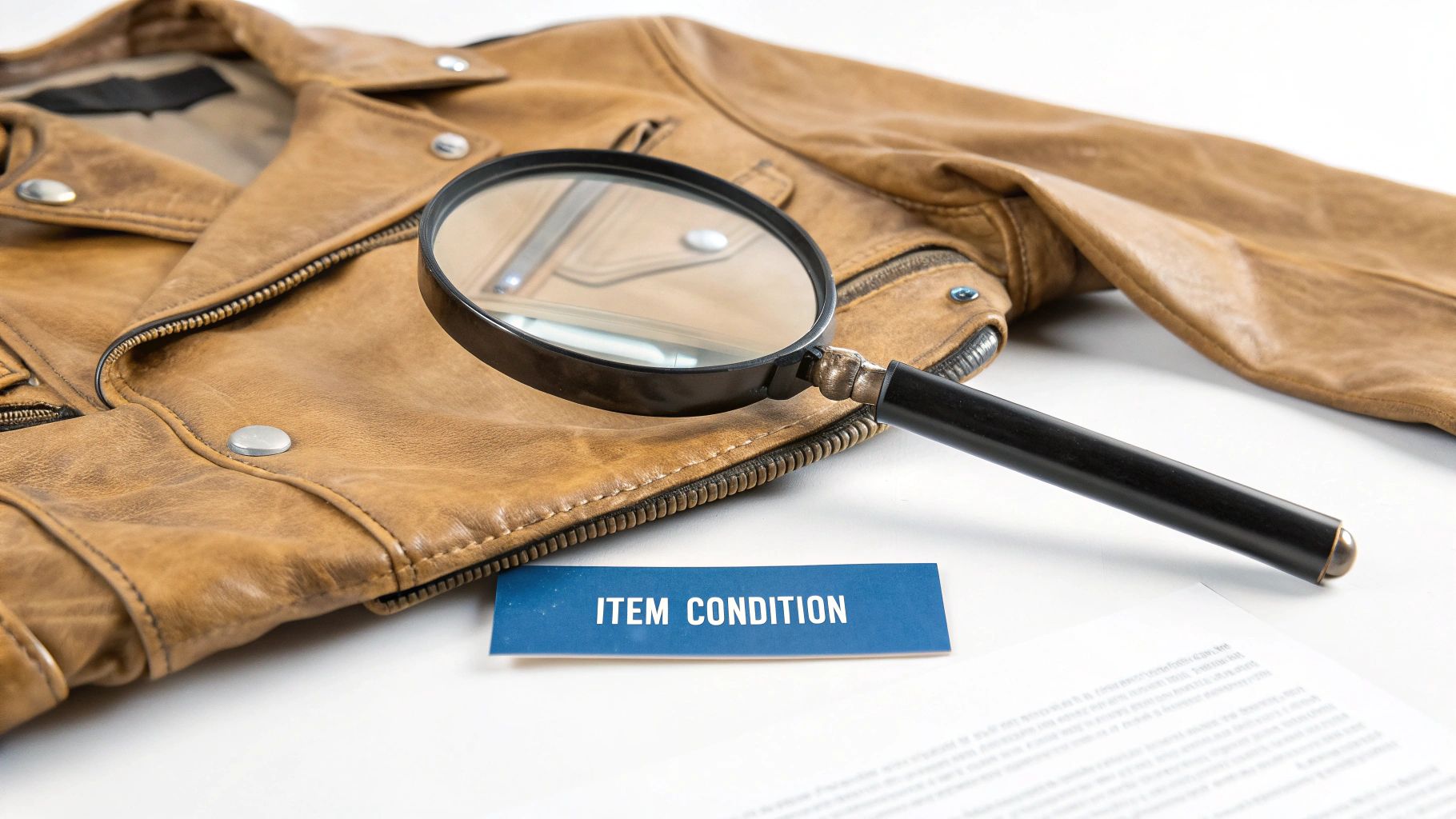
Learning to grade an item’s condition is probably the most important skill you can develop. It’s the one factor you have the most control over in your pricing, and it can literally double an item's value—or cut it in half. Phrases like “good for its age” are just too vague. Your buyers need specifics, and your pricing needs to be built on a solid foundation.
Think of yourself as a detective. Every tiny scuff, stain, or repair tells part of the item’s story and has a real impact on what it's worth. When you get this right, you can price your items with confidence, easily explain your reasoning to customers, and build a reputation as a seller people can trust.
The Professional Grading Scale
To get away from pure guesswork, you need a system. Adopting a standardized grading scale brings consistency to your pricing and gives buyers a clear picture of what they’re getting. Most professional dealers I know use a five-tier system that looks something like this.
Mint (M): The item is absolutely perfect, as if it just came off the factory line. It often still has its original tags or is in the original box. Honestly, you'll almost never find a true vintage piece in mint condition.
Near Mint (NM): This is as close to perfect as you can get. It might have the faintest sign of handling, like a tiny, invisible scuff on the bottom of a vase. There are no real flaws to speak of.
Excellent (EX): The piece shows very light, gentle wear that you'd expect from its age. Think of some light creasing on the elbows of a leather jacket. It's structurally sound with no major damage, repairs, or stains.
Good (G): Here, you can tell the item has been used. It has visible wear and noticeable flaws—maybe a small chip, a faint stain, or some fading. The piece is still completely functional and looks good.
Fair (F): Items in fair condition have significant damage that hurts how they look or function. We're talking large cracks, missing parts, or heavy staining. These are often sold for parts, for repair, or just as decorative props.
An item’s condition has a direct link to its value. A piece in Mint condition can fetch 100% of its top market value, while an Excellent one might land in the 70-90% range. An item graded as Fair, however, could be worth as little as 30-50% of a perfect example.
What to Look For: A Detective's Checklist
A quick once-over isn't enough. You have to be methodical. Use your eyes, your hands, and even your nose to examine a piece from top to bottom. The smallest flaws can be easy to miss, and finding them is what separates an amateur from a pro. Knowing what to look for is a huge part of learning how to identify antiques and vintage treasures.
Here are the clues I always look for:
Structural Damage: This is the big stuff. Check for cracks in pottery, tears in fabric, deep scratches in wood, or dents in metal. Don't just look—run your fingers along seams and edges to feel for hidden chips or splits.
Surface Wear: Next, look for more subtle signs of a life lived. This could be scuffing on the base, utensil marks on a plate, or pilling on a sweater. I find that holding an item up to a bright light and tilting it can reveal a world of fine scratches you'd otherwise miss.
Color and Fading: The sun is not a friend to vintage items. Compare the color on an exposed area to a part that's been covered, like the underside of a figurine or the inside of a shirt collar. Uneven fading can be a major value killer.
Repairs and Alterations: Old repairs can be tricky to spot but are critical to your assessment. Look for mismatched threads on a quilt, tiny glue lines on a ceramic, or paint that doesn't quite match the rest of the finish. A blacklight is a great tool for this—it can make modern glues and touch-ups glow.
Odors and Stains: Don't forget to give it a sniff! Lingering smells from smoke, mildew, or mothballs are notoriously hard to get rid of and will lower the value. Be sure to check for hidden stains, like water marks inside a vase or discoloration in the armpits of a vintage dress.
Following a process like this helps you write detailed, honest descriptions. It builds trust with your buyers and makes sure your pricing is always on the money.
Uncovering the Power of Rarity and Provenance
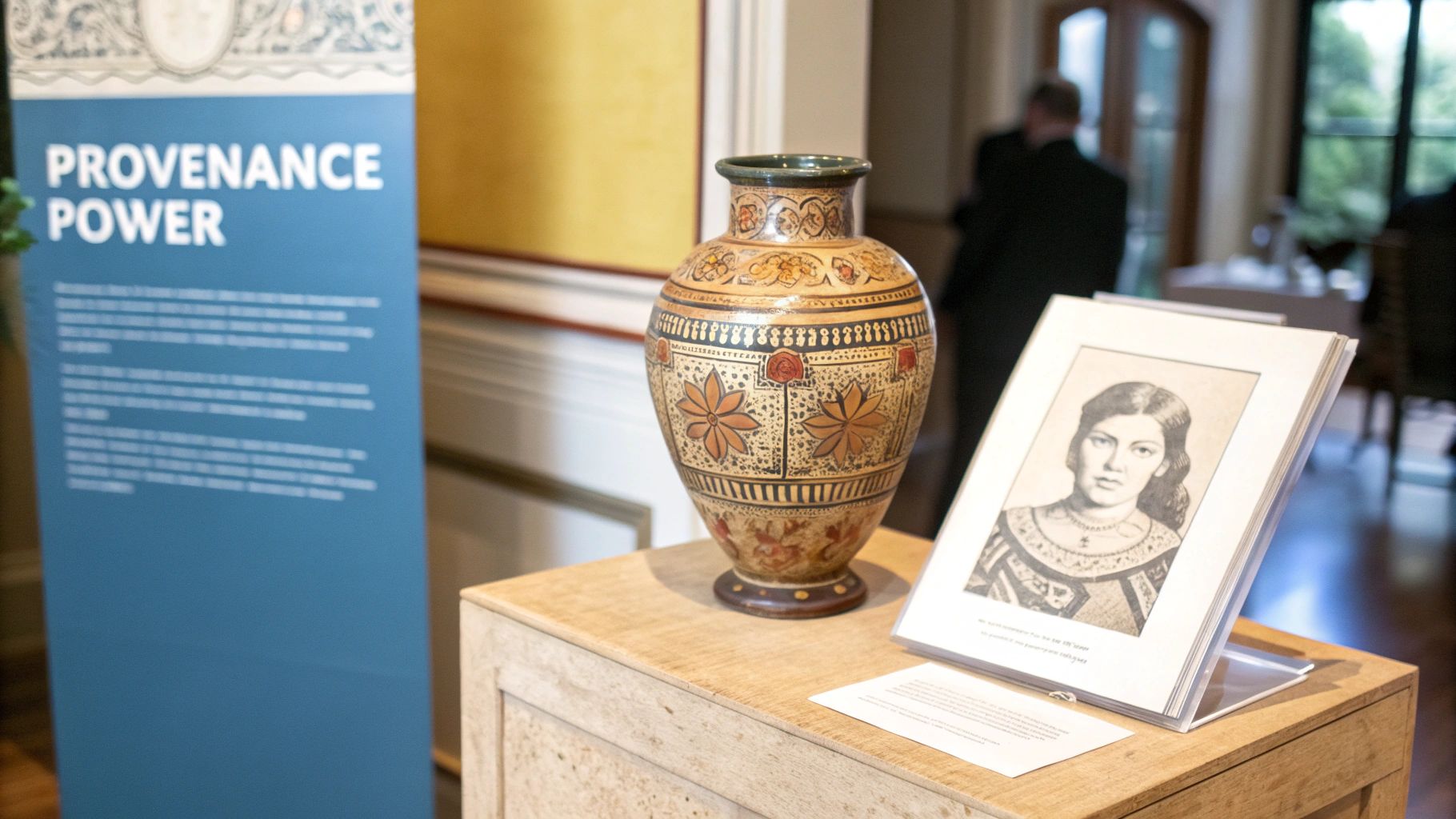
If an item's condition sets the baseline for its value, then rarity and provenance are what can send that price soaring. This is where an object's story really comes to life, turning something that might seem ordinary into a treasure collectors will fight for.
Rarity is simple supply and demand—how many of these are actually out there? Provenance, on the other hand, is the item's life story, its documented history. When you have both, you’ve got something special that buyers will pay a premium for.
Decoding True Rarity
It's a classic rookie mistake to think that old automatically means rare. Just think about the Ford Model T. Millions were made, and while they're certainly antiques, a standard model isn't exactly a unicorn. True rarity is about genuine scarcity, which can pop up for a few key reasons.
- Limited Production Runs: Some things were exclusive from day one. Maybe it was a designer's limited-edition chair or a small pottery's experimental glaze that only lasted a season.
- Low Survival Rates: Think about how many delicate glass vases or paper advertisements from the 1930s actually survived. Things that were fragile or disposable are naturally harder to find in good shape decades later.
- Unusual Variations: Sometimes, the "mistakes" are what become valuable. A factory error, a weird color that was quickly pulled from production—these oddballs are exactly what serious collectors hunt for.
Vintage Pyrex is the perfect example. You can find a standard bowl in a common pattern for a few bucks any day of the week. But find a "Lucky in Love" casserole dish? It was a one-day promotional item from 1959, and it's so incredibly scarce that collectors have paid thousands for one. That's rarity in a nutshell.
Rarity isn't just a trait; it's a market driver. When an item is hard to find, it defies typical pricing models. The value shifts from being based on utility to being based on desirability and the competitive nature of collecting.
The Value of a Good Story: Provenance
Provenance is, quite simply, an item's biography. It’s the proof of where it's been, who owned it, and the life it has lived. A plain wooden chair is just a chair. But a plain wooden chair with a photograph showing it in a famous artist's studio? Now it’s a piece of history.
That story transforms an object from a simple commodity into a unique artifact. For a buyer, owning something with a tangible connection to the past is a powerful motivator, and they are almost always willing to pay more for it.
How to Uncover and Document Provenance
Think of yourself as a detective. You're hunting for clues and gathering evidence to build a case for your item's history. Even the smallest details can add up to a big increase in value.
Here’s what to look for to build a strong provenance:
- Original Paperwork: This is the gold standard. Original receipts, certificates of authenticity, old instruction manuals, or even the original hang tags are solid proof of an item's origins.
- Photographic Evidence: An old family photo showing that piece of furniture in the living room in 1965 can be incredibly powerful. It confirms the item's age and shows it’s been in a single collection for a long time.
- Maker's Marks and Signatures: Flipping an item over to find a stamp, label, or signature is often the first step. Researching these marks can connect your piece directly to a specific maker, company, and time period.
When you can present clear, well-documented provenance, it can be the difference between a good sale and a great one. If you think you have something with significant value, it’s worth understanding how professionals formalize this process. Learning more about getting a professional appraisal for antiques can solidify your item's story and give buyers the confidence they need to pay top dollar.
Finding Accurate Compts with Market Research
Trying to price a vintage piece based on a gut feeling is a recipe for disaster. It's like wandering through a new city without a map—you might get somewhere eventually, but you'll probably take a few wrong turns and end up leaving money on the table. To price with confidence, you need hard data. This is where solid market research turns your pricing from a wild guess into a smart, strategic decision.
The entire game is about finding "comps"—shorthand for comparable sales. You're looking for recent sales of items that are as close to yours as humanly possible. Think of yourself as a real estate agent for your vintage finds. An agent doesn't just pull a number out of thin air for a house; they look at what similar homes in the same neighborhood have actually sold for. That’s your job now.
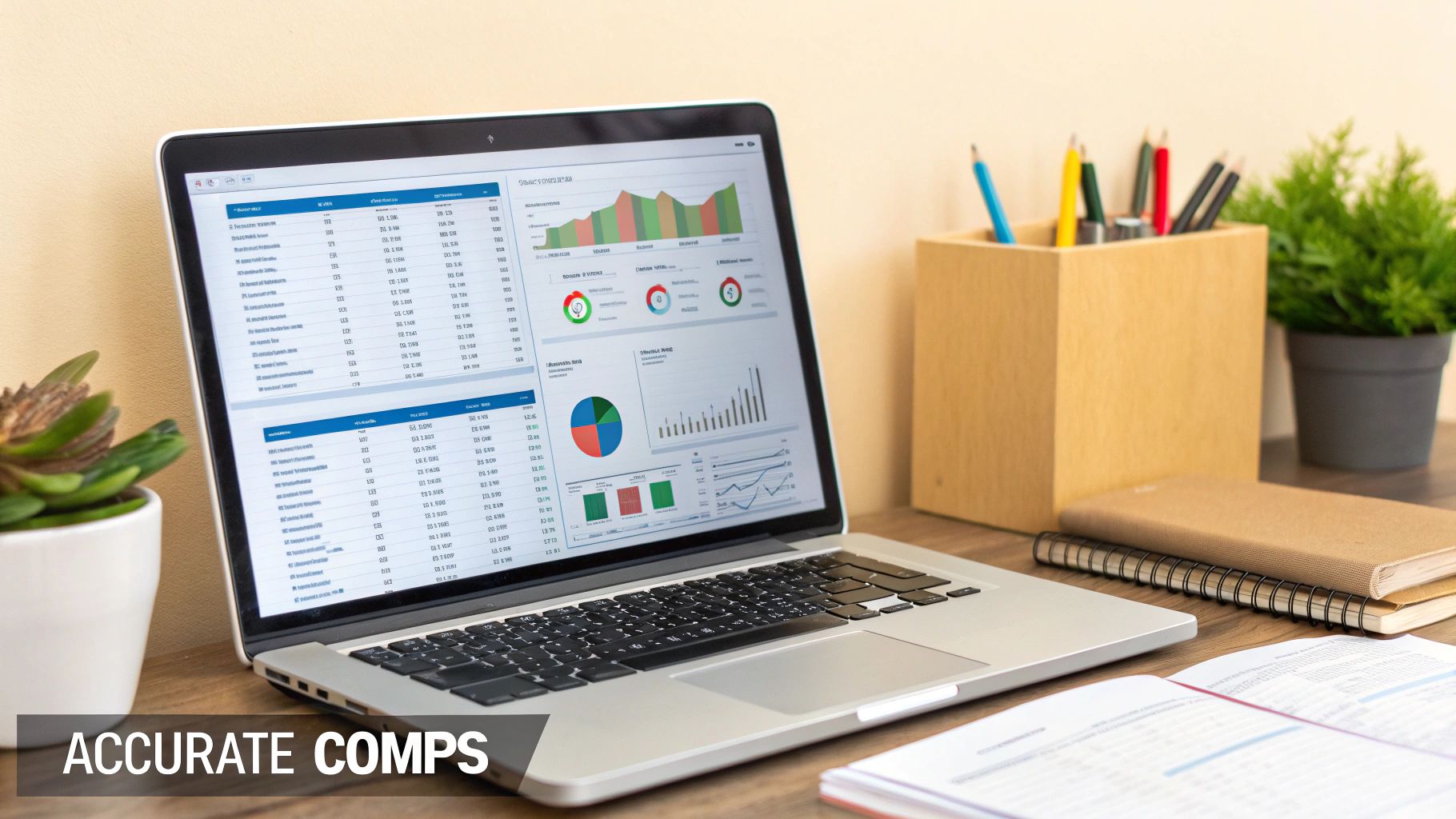
This screenshot right here? This is the single most powerful tool in your pricing arsenal. It’s the "Sold" filter on eBay, and those prices in green represent real money that a real buyer paid for an item. This data is infinitely more valuable than looking at active "For Sale" listings, which only tell you what a seller hopes to get.
The Power of Sold Listings
Let this be your golden rule: an item is only worth what someone has recently paid for it. Asking prices are just wishful thinking. Sold prices are facts. Getting comfortable with filtering by "Sold Items" on marketplaces is the most critical research skill you can build. It's your direct pipeline into what the market is doing right now.
And that market is bigger than ever. The global collectibles market, which is where vintage goods live, was valued at a staggering $496.2 billion in 2023 and is only getting bigger. This boom is driven by online platforms that connect millions of buyers with unique items, making real-time data more crucial than ever for nailing your prices.
Your Go-To Research Platforms
While eBay is usually the first stop, a savvy seller never relies on just one source. Different platforms attract different kinds of buyers, and that can lead to different price points for the exact same thing.
Here’s where you should start your search:
- eBay: The undisputed king for sheer volume of data. Use the "Sold Items" filter to see what has sold in the last 90 days. It's your best bet for common to moderately rare items.
- Etsy: A goldmine for handmade, artisan, and carefully curated vintage. Prices here can often be higher because buyers are paying for the seller's unique eye and presentation. A good trick is to search for your item and look for listings that have already sold out.
- WorthPoint: This is the secret weapon for serious resellers. It’s a subscription service with a massive database of sold items from hundreds of auction houses and online marketplaces, with data going back more than a decade. It's an absolute must-have when you need to find comps for rare or unusual items that haven't popped up on eBay lately.
Pro Tip: When you find a comp, you have to compare apples to apples. Look at every detail: condition, maker's marks, size, color, and any flaws mentioned in the listing. A "Near Mint" piece will always fetch a higher price than one that's just in "Good" condition.
Comparison of Vintage Research Tools
To help you decide where to focus your efforts, here’s a quick rundown of the most popular platforms and what they do best. Each one has its strengths, and using them together gives you the most complete picture of your item's value.
| Tool/Platform | Best For | Key Feature | Cost |
|---|---|---|---|
| eBay | Common to moderately rare items | "Sold" filter shows 90 days of sales data | Free |
| Etsy | Curated vintage, artisan goods, decor | See what has sold out; reflects trend-driven pricing | Free |
| WorthPoint | Rare and unusual items, antiques | Database of 20+ years of auction/sales data | Subscription |
| LiveAuctioneers | Niche collectibles, art, furniture | Aggregates results from thousands of auction houses | Free to browse |
Ultimately, having a few of these tools in your back pocket means you're prepared for whatever you find, whether it’s a common collectible or a one-of-a-kind treasure.
Beyond the Big Marketplaces
For those higher-end or truly oddball items, you’ll need to dig a little deeper. Knowing where to look is half the battle, and there are many specialized online price guides for antiques that can give you a more focused view on specific categories.
Don't be afraid to branch out to these resources:
- Specialist Auction House Archives: Websites for major players like Heritage Auctions, Christie's, or Sotheby's have searchable archives of past results. This is invaluable if you're pricing fine art, high-end jewelry, or rare historical memorabilia.
- LiveAuctioneers and Invaluable: These sites are aggregators, pulling in catalogs and results from thousands of smaller auction houses across the globe. They are fantastic for tracking down comps for niche collectibles that you just won't see on eBay.
- Collector Forums and Facebook Groups: While they aren't direct pricing tools, these online communities are packed with passionate experts. If you've searched everywhere and come up empty, posting clear photos and asking for insights in a relevant group can often provide the crucial piece of information you were missing.
By making a habit of using these resources, you'll build a reliable, repeatable process. You’ll stop guessing and start making data-backed decisions that put more money in your pocket and build your reputation as a seller who really knows their stuff.
How Trends and Location Affect Your Pricing
An item’s value isn't static. It breathes, shifts, and changes based on what's hot and where you're selling it. Think of it like a house—a gorgeous home in a booming city is worth a whole lot more than the exact same one out in the middle of nowhere. Vintage pieces follow the same rules.
Two invisible forces are always tugging at your price tag: cultural trends and geographical location. Getting a handle on these can mean the difference between a fast, profitable sale and a piece that collects dust for years. You’re not just selling an object; you're selling a commodity in a living, breathing market.
Riding the Wave of Popular Trends
Trends can create a sudden, almost frantic, demand for certain styles. Pop culture is usually the culprit. When a hit show is dripping with 1970s fashion, you can bet that bell bottoms and prairie dresses will start flying off the shelves. The real trick is to see these waves coming early and adjust your prices to meet that new surge of interest.
If you wait too long, you'll miss the peak. Once a trend cools, prices can plummet just as fast, leaving you with stock that's suddenly a much harder sell.
Here’s how you can stay ahead of the curve:
- Keep an Eye on Social Media: Platforms like Instagram and TikTok are where trends are born. See what the big names in fashion, design, and home décor are posting about.
- Watch Pop Culture: Pay attention to what's happening in movies, streaming shows, and celebrity fashion. A single vintage piece in a popular series can create a massive ripple effect.
- Follow Design Publications: Interior design magazines and blogs often signal what styles are about to become popular in the coming months.
Timing is everything. The goal isn't just to sell an item, but to sell it right at the peak of its cultural relevance. When you capitalize on a trend, you're not just selling a piece of history—you're selling a piece of the now.
Why Your Location Dictates Value
Where you sell an item can dramatically change its final price. Local tastes, regional history, and the number of collectors nearby create these little micro-economies for vintage goods. A sleek Mid-Century Modern credenza, for example, will almost always sell for more in a design-savvy city like Los Angeles or Austin than it would in a small, rural town.
This is a fundamental concept for pricing vintage accurately. Different places have completely different market dynamics. For instance, early American folk art will fetch top dollar at a New England auction, where it has deep historical roots, but it might not get a second look in London. Likewise, Ming dynasty vases are most valuable in Asian markets like Hong Kong, where bidders are willing to pay a premium. If you want to dive deeper into this, you can discover more insights about antique pricing guides on Curio.app.
Strategies for Local vs. Online Selling
Knowing about this geographic sweet spot helps you figure out where to sell your piece. Your strategy should change depending on the item and who you're trying to reach.
Local Selling (Flea Markets, Antique Malls):
- Best For: Big, heavy stuff like furniture that costs a fortune to ship. It’s also perfect for items with strong local appeal, like memorabilia from a beloved regional sports team.
- Pricing: Check what similar items are going for in your specific area. Your price might be lower than online comps, but you save a ton on shipping and platform fees.
- Best For: Smaller, shippable items or things with a niche following that's spread out all over the country (or the world). This is how you find that one collector a thousand miles away who has been searching for that rare piece of Scandinavian art glass you have.
- Pricing: Here, you can aim for a national or even global market price, which often means you can ask for more. Just don't forget to build the cost of proper shipping and insurance into your final price.
Pulling It All Together: Your Final Pricing Strategy
You've done the digging, gathered the intel, and now it’s time to put it all together. This is where your research transforms into a real, defensible price tag for your vintage piece. Think of it like a chef who has prepped all the ingredients—now you have to combine them perfectly to create the final dish.
The mission here is to move from a general market value to a specific price for your item. This ensures every unique detail is accounted for, letting you price competitively without leaving money on the table.
The Base and Adjust Method
One of the most straightforward and reliable ways to do this is with the Base and Adjust Method. It’s a simple, two-part framework that works for just about anything you’ll price.
Find Your Base Price: Start with the average "sold" price you found for similar items during your research. This number is your anchor—it's a real-world starting point based on what buyers have actually been willing to pay recently.
Adjust Based on the Four Pillars: Now, you'll fine-tune that base price. Go through each of the four core value drivers—Condition, Rarity, Provenance, and Demand—and adjust the price up or down based on how your item stacks up.
This method keeps your pricing grounded in hard data first, then layers in the unique, subjective qualities of your item. It’s the difference between pricing with your gut and pricing with confidence.
Your Final Pricing Checklist
Use this checklist to walk through the adjustment process. How does your piece compare to the ones you found in your research?
- Condition: Is your item in better-than-average shape? You can probably add 10-20% to the base price. If it has a few more dings and scratches than the comps, you might need to subtract 15-30%.
- Rarity & Provenance: Does your item have a rare maker's mark, a desirable colorway, or a documented history that the others lacked? This is where you can justify a serious premium—sometimes 50% or even more.
- Platform: Where are you selling it? A curated marketplace like Etsy might support a slightly higher price than a general platform like eBay. If you're selling in a local antique booth, you have to account for overhead, but you also don't have to worry about shipping. For a deeper dive, check out this guide on how to price used items.
- Wiggle Room: Do you want to list at a firm price, or are you open to offers? Many sellers build a 10-15% buffer into their asking price. This gives you room to negotiate and helps the buyer feel like they got a great deal.
By following this simple, structured approach, you build a logical and profitable pricing strategy that you can use again and again for any vintage treasure you find.
A Few More Tricky Pricing Questions
Even with a solid game plan, you're bound to run into some head-scratchers when pricing vintage. Let's tackle a few of the most common curveballs that come up when you're out hunting for treasures.
These situations often don't fit neatly into any pricing formula and require a bit of creative thinking. Knowing how to handle them is what separates the pros from the amateurs, helping you maximize profit and keep your inventory flowing.
What If I Can't Find a Single Comp for My Item?
First off, don't panic. When you've got something that seems truly one-of-a-kind, you just have to shift your strategy. Instead of looking for an identical twin, you'll need to break the item down into its basic parts.
Think like a detective and investigate its core attributes:
- The Maker: Is there a signature, a stamp, or a maker's mark? Who made this?
- The Materials: What is it made of? Are the materials valuable on their own?
- The Style Period: What era does it scream? When was it likely created?
From there, you can start looking for comps for other items from the same brand, made from the same material, or from the same time period. Even if the form is different, you can piece together a logical price based on its relative quality and craftsmanship compared to those other pieces.
Here's a pro tip for unique finds: list the item for a price you feel is strong, but be sure to turn on the "Or Best Offer" option. This lets the market tell you what it's worth. You might be surprised.
How Much Do I Knock Off for Minor Flaws?
This is a real "it depends" situation. There’s no magic number here; the right discount is all about the flaw itself and how desirable the item is.
A tiny, nearly invisible scratch on a common piece of glassware might call for a 10-20% price drop from its perfect-condition value. But a similar flaw on an incredibly rare, in-demand collectible might barely make a dent in the price.
The golden rule is transparency. No matter what, you have to photograph every flaw up close and describe it clearly in your listing. It builds trust with your buyers and is your best protection against returns and headaches later.
Should I Clean or Restore an Item Before I Sell It?
This is a big one, and getting it wrong can be a very expensive mistake.
For most durable things—glassware, ceramics, solid furniture—a gentle, careful cleaning is almost always a good idea. It just presents better.
But for certain items, cleaning can absolutely tank the value. Never, ever clean old coins, antique documents, or anything with a beautiful, age-earned patina. And unless you are a professional conservator, stay away from major restorations.
The safest bet? Sell the item as you found it. Describe its condition honestly and let the new owner make the call on any restoration work.
Stop guessing and start knowing. With the Curio app, you can get instant identification, historical context, and appraisal estimates for your vintage finds right from your phone. Download Curio today and turn your curiosity into confidence. Find out more at https://www.curio.app.
